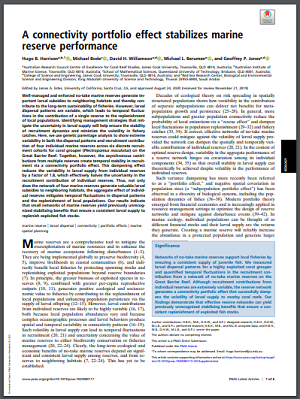
Well-managed and enforced no-take marine reserves generate important larval subsidies to neighboring habitats and thereby contribute to the long-term sustainability of fisheries. However, larval dispersal patterns are variable, which leads to temporal fluctuations in the contribution of a single reserve to the replenishment of local populations. Identifying management strategies that mitigate the uncertainty in larval supply will help ensure the stability of recruitment dynamics and minimize the volatility in fishery catches. Here, we use genetic parentage analysis to show extreme variability in both the dispersal patterns and recruitment contribution of four individual marine reserves across six discrete recruitment cohorts for coral grouper (Plectropomus maculatus) on the Great Barrier Reef. Together, however, the asynchronous contributions from multiple reserves create temporal stability in recruitment via a connectivity portfolio effect. This dampening effect reduces the variability in larval supply from individual reserves by a factor of 1.8, which effectively halves the uncertainty in the recruitment contribution of individual reserves. Thus, not only does the network of four marine reserves generate valuable larval subsidies to neighboring habitats, the aggregate effect of individual reserves mitigates temporal fluctuations in dispersal patterns and the replenishment of local populations. Our results indicate that small networks of marine reserves yield previously unrecognized stabilizing benefits that ensure a consistent larval supply to replenish exploited fish stocks.














